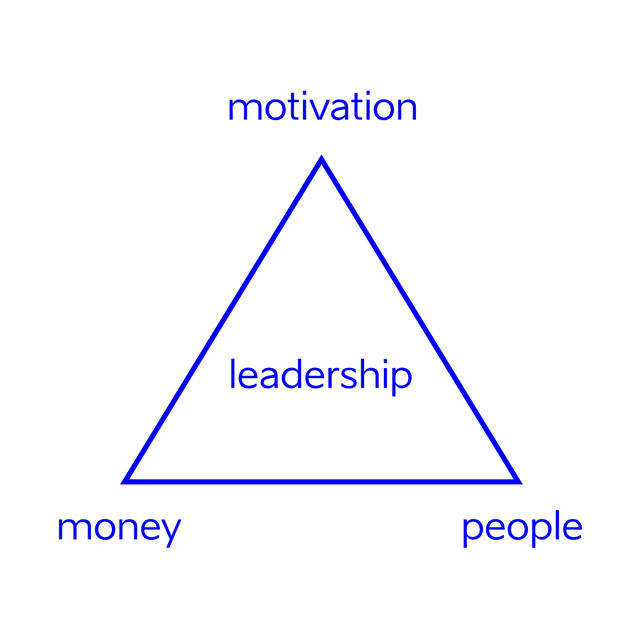Money, people and motivation - you need at least two to succeed.
Photo credit to Michał Parzuchowski
Life is like an infinite game of Jenga. You need to keep it balanced, move bits around to move forward and you need to cooperate to get as far as possible without failing to keep playing.
Note: The objective of finite Jenga would be to get the other player(s) to fail. This is why I stressed on the infinite part.
I recently started thinking about the subject of what it takes to succeed with an idea. I couldn't get the internal discussion out of my head while walking or taking a shower. I think I've finally come to a conclusion after a week.
You need a maximum of three fundamental things to run a project or organization successfully, but you can start with two, and completing the triangle almost guarantees success.

Equilateral triangle of success. All three tips represent one fundamental aspect of a successful organization. Leadership is the one who balances all three parts from the inside.
Motivation

You can't achieve anything without motivation.
Motivation drives an organization forward. Combined with trust between the team members, you have a tight team that is willing to do everything it takes to achieve goals and help each other succeed.
Helping each other leads to a chain reaction of success. When people feel safe in their environment, they are willing to experiment and go out of their comfort zone. They are willing to take risks because they are not afraid of failure.
When people are not afraid (but still aware of the risk) of failure, they are willing to innovate and that pushes the limits of what is possible.
However, there is hope. As a leader, you don't have to have the motivation of people before you've even started. You have the power to create that motivation and belief.
There are two ways you can pull in people. You can have them show up to make someone proud or you can have them show up to prove to themselves that this is who they are. If you can take advantage of these two methods, you're on your track to be a great leader. Just remember that the will to prove or to make someone proud needs to come from within the person, but the fire can be lit with a match.
When Martin Luther King spoke in Washington, he did not have a social media campaign. He did not print ads in newspapers. There were no invitations.
All he did was share what he believed. He shared his motivation.
He went around and told people what he believed. The people he shared his beliefs with took what he told and made his cause their own. The people then shared his belief, which was now their own, with more people.
The time came and 50 000 people showed up to hear him speak. On the right day, the right hour at the right place.
They did not show up for him, they showed up for themselves and for those they strived to make proud.
Share your motivation as a leader, it will get those who share your cause to come along with you.
Money

It's hard to achieve great things without funding or in-kind. Paying people for their time if they are not volunteers, keeping people fed, travel expenses - everything costs you something. If you can't pay for anything, progress slows down to a crawl.
This is one of the reasons the saying "money makes the world go round" exists. It exists because it's true.
However, you don't have to start out with money to succeed. Just like any of the three fundamental aspects of success, you need only two to complete the triangle for the third and ultimately for success.
Let me share with you a story that was shared with me during my first AIESEC conference.
Rebuild the triangle, rebuild the organization.
This story takes place in Turkey. The girl who shared the story was working in an AIESEC entity that was standing on the edge of a cliff. Below the cliff was the process of closing down an AIESEC entity. They had under five members, they were 5000€ in debt and they were at the end of the road.
But they were not going to give up without a fight. So they had two things - people and motivation. They had two of the 3 aspects of a successful organization. So they set out to rebuild the triangle. They could not promote their cause on social media so they went on the streets. They had nothing but a debt, people and a cause. They had a motivation.
They had a why.
So they shared their cause and told people about their situation. People who cared made the cause their own and donated. Enough people were motivated to help and gave what they could spare. People who believe what you believe are your greatest asset.
She and the members they had left managed to pay off the debt. Not only that, they managed to recruit new people without any social media campaigns. They managed to find people interested in going abroad with them.
They managed to build a road where there was none.
Today their AIESEC entity is a very successful one and they have all three aspects covered. They went from two to three aspects and rebuilt the triangle.
People

One common resource we all share is time. You can not directly buy more time into your day, but you can get people to work with you towards a goal. You can not refund time and everyone has the same amount of time in their day. How they choose to / have to spend it is a different story, though.
Time is non-refundable and finite for humans.
People have different skills that vary across a very wide range. This is why having people to work with is so important - you need to combine the skills and time of multiple people to achieve goals which affect many people.
As I shared in the previous section, with the help of people you can build out the triangle and stabilize it. With people, you can get funding directly or indirectly, looking for funding. With people, you can share a message to spread the cause or motivation.
This is the value of people in an organization. They are the cogs of the metaphorical clock.
Principle of equilateral stability
The principle is incredibly simple. As a leader, your job is to keep all three sides in balance. If one increases, you get to choose which way to balance the equilateral triangle - do you invest in increasing the remaining two to make the organization/project larger or do you try to pull the one that changed back?
If you have two of the three aspects, you can draw a line. From this line, you can draw an equilateral triangle. Once the complete triangle has been built, it can support itself by clearly showing you where the instability is.
Great leadership is able to recognize signs of trouble and direct resources to balance out all three sides of the equilateral triangle to keep the stability.
An equilateral triangle can only be stable if you have all three sides. You can restabilize if you have two left. If you lose all but one, you need to completely rebuild your project or organization. If you lose all three, the organization/project has failed.
The triangle can grow and shrink, rotate - you can position it however you want, but all three sides must remain balanced to keep stability.
Conclusion & Call to Action
This is the result of my internal discussion. What do you think? Am I on to something here or is everything I talked about bullshit? Let me know by replying to this post.
I'm looking forward to hearing the thoughts of you wonderful steemians!


I don't know if I am really too hippie or emotional person, but I think PASSION is really important when wanting to gain success. You need to be passionate about what you do. If you are passionate, then comes the motivation. If you're passionated and motivated, then comes the people and if the people come, comes the money.
IMO
If you're passionate about something, then that is your motivation. They are not exclusive to each other :)
IMO people can't be successfull if all they have is money, and there is no motivation behind it! Or if there's any they might have only a indirect motivation. Eg. people HODLing a coin because they see an upwards trends, not because they beleave in the people behind it!
The point I was getting at is that two is the tipping point. If you manage to get two, you can get the third much more easily and indirectly reach success. It's much harder to collapse the triangle once it has been built, but to build the triangle in the first place, reaching two out of three is the tipping point.
DIdn't look at it from that POV.
Did you miss to explain the people? Not quite sure how they are involved in your triangle yet.
I sure did, thanks for telling me.